Cooperative of Farmers’ Association with Communities for Ecological and Organic Scale Production of Rice Industry
16.12.2022
SUBMITTING ORGANIZATION
Soil and Water Conservation Bureau (SWCB), Council of Agriculture Executive Yuan, R.O.C. (Chinese Taipei)
OTHER CONTRIBUTING ORGANIZATIONS
Taiwan Landscape Environment Association
National Chung Hsing University, R.O.C (Chinese Taipei)
DATE OF SUBMISSION
13/10/2022
REGION
Asia
COUNTRY
Chinese Taipei
KEYWORDS
Eco-farming, green products, payment of ecosystem services, rural regeneration
AUTHORS
Chen Yang Lee1, Ci-Fang Ciou2, Ling-Tsen Chen1 Chen-Fa Wu3*, Szu-Hung Chen4, Chen-Jung Liu2, Ching-Chien Huang5, Hao-Yun Chuang1, Ming Cheng Chen1, Wen-Cheng Huang2, Chun-Hsien Lai6, and Luu Van Thong Trac3, Hao-Wei Hsu6
1. Soil and Water Conservation Bureau, No. 6, Guanghua Road, Nantou City 540, R.O.C (Chinese Taipei)
2. Soil and Water Conservation Bureau Taichung Branch, No. 22, Yangming Street, Fengyuan District, Taichung City 420, R.O.C (Chinese Taipei)
3. Department of Horticulture, National Chung Hsing University, No. 145, Xingda Road, South District, Taichung City 402, R.O.C (Chinese Taipei)
4. International Master Program of Agriculture, National Chung Hsing University, No. 145, Xingda Road, South District, Taichung City 402, R.O.C (Chinese Taipei)
5. Wu Feng Farmers’ Association, No. 10, Side Rd., Wu Feng Dist., Taichung City 413009, R.O.C (Chinese Taipei)
6. Taiwan Landscape Environment Association (TLEA), 10F, No. 118, Mingcheng 2nd Road, Sanmin District, Kaohsiung City 80794, R.O.C (Chinese Taipei)
* Corresponding: Chen-Fa Wu (cfwu@dragon.nchu.edu.tw)
Summary Sheet
The summary sheet for this case study is available here.
Abstract
Wu Feng District is located in southern Taichung, Central Western Taiwan, a suburban district with a population of 65,094 in 2020. The district is famous as a mainly agricultural township. Under a subtropical monsoon climate, Wu Feng District’s alluvial plain relies on dense hydrological systems and seasonal rainfall for water supply for irrigation, favorable for cultivating abundant crops. Yichuan aromatic rice is a representative product of agricultural production. However, low farmers’ incomes and excessive use of pesticides have been thorny problems hindering regional development. This raises concerns about resolving conflicts among the farmers and protecting the farmland ecosystem for wildlife habitats. Faced with this situation, a Farmers’ Association in Wu Feng District, under the management of the Council of Agriculture, determined to transform their community towards sustainability, playing catalytic roles in many implementations. The Farmers’ Association conducted industry-university cooperation with the Taiwan Agricultural Research Institute to provide technical guidance to the farmers to promote locally produced rice. Black-winged Kite (Elanus caeruleus) as an indicator species for agricultural products produced by organic processes to maintain biodiversity conservation. Soil and Water Conservation Bureau assists communities in surveying the distribution of Black-winged kites and practices a conservation and environmental education program. Wu Feng Farmers’ Association and National Chung Hsing University joined hands to form partnerships in establishing a verification mechanism for producing organic rice. The multi-stakeholder platform enabled the community to approach transformations, particularly in increasing the farmers’ incomes and restoring the farmland ecosystem by changing farmers’ perceptions and farming practices toward organic farming. To achieve sustainability, a holistic approach with a strong connection among multi-stakeholders is required to maintain the solid agricultural development of the area. A practical and effective framework from the case of the Wu Feng district represents a promising new direction for policymakers in terms of developing a sustainable agriculture landscape, ensuring the farmers’ livelihood and the integrity of ecosystems.
Background
Approximately 98.08 km2 of Wu Feng District’s terrain extends 14.83 km long from East to West and 8.83 km long from North to South (Figure 1). It is composed of a rolling-hill area on the Eastern side, with an altitude from 100 to 600 m. An alluvial plain of Wu River is situated on the Western side, with an altitude between 40 and 100 m. Along the terrain, the rivers in Wu Feng District, including the Dali River, Caohu River, Beigou River, Qian River, and Dadu River, flow westward from the highlands in the East. In addition, the hydrological system of reservoirs and canals in the district is well-developed. In 1765, the Wandouliu Canal was built, and following in 1838; the Atabu Canal was built. Since 1948, the Chelun Reservoir, Wu Feng Canal, Wangcuo canal, Huan-a Canal, Dingtai Canal, and Nanshi Canal have been constructed successively, with most of the water coming from the Wu River.
Wu Feng District is characterized by the subtropical monsoon climate, with an annual average temperature of 19.4°C. The period of highest temperature is from May to September when the temperature can reach an average of 20°C. The average temperature during January and February is about 16°C to 17°C. The district receives most of its rainfall in the summer, accounting for more than 75% of the annual rainfall. In the winter, the community experiences less rainfall with drier weather. The average yearly rainfall is between 1400 and 1670 mm. Due to the regional climatic conditions, the soil in the Eastern mountainous area has developed into a weakly acidic, yellowish-brown sandy soil. With steep slopes and good drainage, the land is mainly planted with lychee and longan, covering an area of about 3,100 ha. Five streams flow through the plain, while the canal systems are well-developed in the West. The land is covered by sand-shale older alluvial soil and is suitable for paddy fields. About 1,700 ha of land is used for rice cultivation, of which 500 ha are planted with Yichuan aromatic rice (aromatic rice variety Tainung 71).
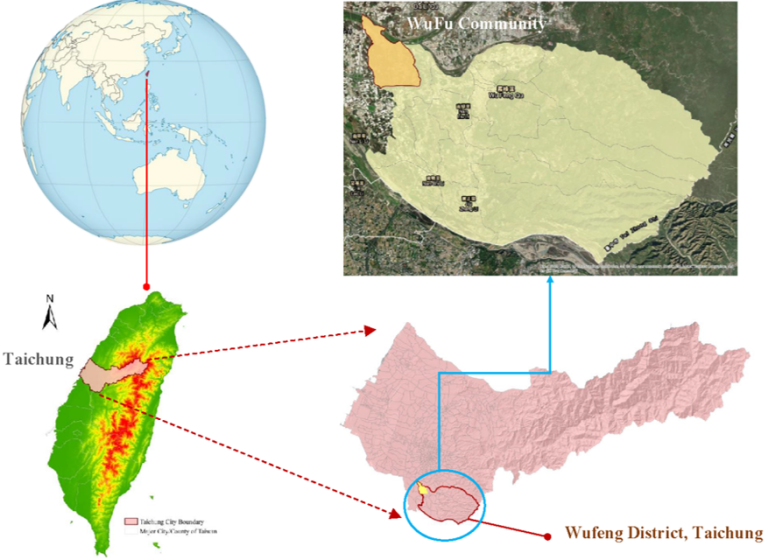
Socioeconomic, environmental characteristics of the area
Agriculture is the leading economic sector in Wu Feng district, with essential crops including longan, lychee, and rice. In 2020, the harvested areas of longan, lychee, and rice were 1,177.35 ha, 499.24 ha, and 2245.84 ha, respectively, with the total yields of 3532.05 tons, 1,248.10 tons, and 11,737.87 tons of the respective crops. In addition to agriculture, there are Wu Feng, Jifeng, and Nanshi industrial parks in Wu Feng district, promoting commercial development and population growth. In 2010, the number of households was 18,750, with 63,975 residents. These numbers increased by 2,126 and 1,119 in families and residents over ten years. Accordingly, Wu Feng District had 20,876 households and 65,094 residents in 2020. In 2020, the arable land in Wu Feng District was 4,439.24 ha. Among the crop category, the cultivation of annual crops, rice paddies, and others occupied 2,026.63 ha, 1,084.59 ha, and 1,511 ha, respectively. In contrast, perennial crops accounted for 2,223.88 ha.
Taiwan has a National Farmers’ Association, 22 Farmers’ Associations of counties (cities) and municipalities, and 279 Farmers’ Associations of townships (towns, cities, districts), with a total number of 1.95 million members nationwide, making it the most popular and influential farmers’ organization. The farmers’ associations in different townships and districts engage in four significant businesses: credit businesses, economic undertakings, insurance businesses, promotion, and education. “Credit businesses” involve financing services for the agriculture, forestry, fishery, and animal husbandry industries and consumer loans, which are the primary sources of surpluses for the farmers’ associations. “Economic undertakings” refer to the diversified economic undertakings that the farmers’ associations can develop, including intermediary businesses of the farmland banks, leases, and transactions of farmland, leisure farms, agricultural tourism, funerals, service centers for the elderly, organization of wholesale and retail businesses of farming materials, as well as international trading companies of farm products. The associations can also produce high-value-added products with local agricultural products and traditional cultures to expand the market domestically and internationally. Such endeavors include online shops for farm products, wines from wineries, health foods, cosmetics products, and souvenirs. “Insurance businesses” involve the efforts to protect the livestock raised by the farmers and the farmers themselves. The businesses include farmers’ health insurance, allowances for elderly farmers, scholarships and bursaries for farmers’ children, consignment sales of property insurances such as car and motorcycle insurance and fire insurance for homes, and personal insurance, including life insurance, death insurance, and annuity insurances. All the services provide better protection for members’ lives and production. “Promotion and education” include conducting the promotion and education of agricultural knowledge for farmers, production and marketing groups, women, and teenagers. For example, with production and marketing groups as the intermediaries, the farmers’ associations would sign a contract with the farmers in items such as rice, fruit and vegetable production, processing, and winemaking, to increase the added value of agricultural products; to nurture future agricultural operators; to create job opportunities for rural women, and to assist teenagers. Some farmers’ associations set up farmer markets and help the farmers sell agricultural and processed products with production records for traceability to develop regional agriculture. In the promotion and education efforts of the Wu Feng District in 2021, 10 assemblies have been held with 5,812 participants, four vocational training sessions have been held with 444 participants, and five on-site learning activities have been held with 440 participants.
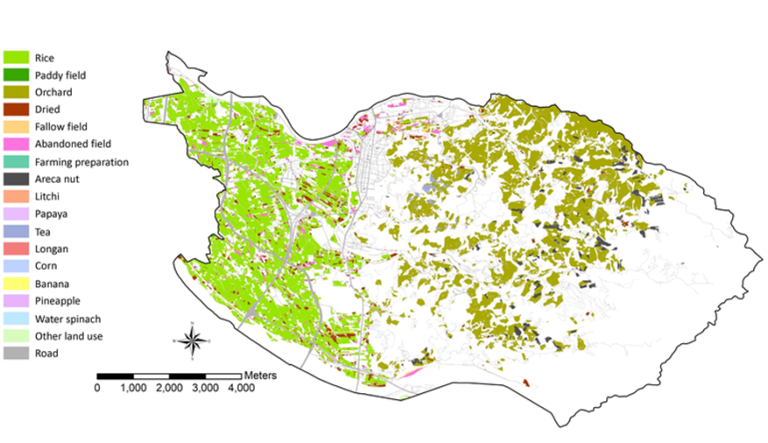
Rationale
Farmers owning small fields gain low income
The arable land in the Wu Feng District covered 4,439.24 ha in 2020. Based on the Wu Feng District farmers’ association members, there are 6,812 farmers, of which 4,749 are males, and 2,063 are females. There are 18 production and marketing groups with 893 members, of which 45 are young farmers (National Farmers’ Association, 2021). According to a farm household report of the Taiwan conducted by the Agriculture and Food Agency with a sample survey in 2017, the average rice-farming area per farm household in Taiwan is 0.96 ha, while in Central Taiwan, the income per hectare from rice farming is about 111,890 NTD. The situations are similar for the farmers in the Wu Feng District. Most farmers work on small farmland and cannot realize economies of scale. How to increase farmers’ income has thus become an important issue.
Pesticides used to increase crop yields have affected raptor populations
The climate of Taiwan is hot and humid, making the crops prone to the harm of diseases and pests. For pest management and increasing crop yields, pesticides and chemical fertilizers are widely used in agriculture. Pesticides are mainly used to kill invertebrates, rodents, or weeds. In addition to impacting ecological habitats, pesticide residues in the environment also threaten the survival of organisms and affect people’s health by contaminating the food. Raptors occupy a higher trophic level in the food web and need more expansive spaces for movement. Their prey can reflect the community structure of the species in a region, and the raptors play an important role in the terrestrial ecosystem. Therefore, the raptors are often regarded as indicator species, which can help evaluate whether the region’s ecosystem is healthy. In addition, the raptors’ food resources include rodents, snakes, birds, and invertebrates, while preventing the infestation of rodents is an important issue in Taiwan’s farmland.
Taiwan’s current rodent control measures include holding a week of national rodent eradication activities in the Spring every year, during which a large among of anticoagulant rodenticides (such as bromadiolone and chlorophacinone) are used in fields at the same time. Secondary poisoning usually occurs as raptors eat poisoned wild rats, and the Black-winged Kite (Elanus caeruleus) is one of the species that suffers. The Bureau of Animal and Plant Health Inspection and Quarantine and the Endemic Species Research Institute commissioned a test for the anticoagulant rodenticide residues in raptors’ livers (Chen & Shyu, 2019). Among the 101 liver samples taken from 11 raptor species, including Crested Serpent-Eagle (Spilornis cheela), Chinese Sparrowhawk (Accipiter soloensis), Oriental Honey-buzzard (Pernis ptilorhynchus), Besra (Accipiter virgatus), Eurasian Kestrel (Falco tinnunculus), Mountain Scops-Owl (Otus spilocephalus), Black-winged Kite (Elanus caeruleus), Collared Scops-Owl (Otus lettia), Crested Goshawk (Accipiter trivirgatus), Brown Wood-Owl (Strix leptogrammica), Brown Boobook (Ninox scutulata), 47 of the samples were detected with anticoagulant rodenticide residues, with a detection rate of 47%. The detected agents included 0.004~0.483µg/g of brodifacoum, 0.002~0.250µg/g of flocoumafen, 0.003~0.102µg/g of bromadiolone, and 0.004~0.016 µg/g of difenacoum (Chen & Shyu, 2019; Table 1). Twenty-eight percent of the samples were detected with two or more rodenticide residues, while the most common types are brodifacoum and flocoumafen (Chen & Shyu, 2019). Although rodent control is imperative because rodents hinder the production of crops and are the vectors of various infectious diseases, the rodent control technique needs to be reviewed. It is necessary to perform rodent control more effectively in the fields while ensuring species conservation and environmental safety at the same time.

Impacts of the farmers’ association on local agricultural management and development
Farmers in Wu Feng District face financial, production, and marketing problems in agricultural operations. From the farmers’ point of view, the above three issues reflect one integrated problem. Therefore, a farmers’ association should consider the difficulties in its operations. Based on this point of view, the farmers’ associations in Taiwan are set up as a type of farmer’s cooperative organization with multi-functions and multi-purposes to realize the planned and integral cooperation between the departments of promotion, credit, supply, and marketing so that they are mutually supportive. However, Taiwan lifted its ban on imported rice since its accession to the World Trade Organization (WTO) in 2002, causing the price of domestically produced rice to fall and affecting farmers’ income. Given this, the government implemented the “Adjustment of Paddy Fields and Uplands Utilization Program” to adjust and control the area of rice fields to maintain the balance between rice production and sales to stabilize the price. In the face of the impacts mentioned above, the positions and actions of the farmers’ associations in the dimensions of guiding the farmers, maintaining stable income, and operation and management innovation are crucial.
The implementation of the Organic Agriculture Promotion Act can effectively increase farmers’ willingness toward organic farming practices
In 2018, Taiwan implemented the Organic Agriculture Promotion Act. With the introduction of third-party verification of products, emphasis on the spirit of guiding the industry, promotion of eco-friendly agricultural operation, encouragement to the setting up of (organic agricultural promotion zones), provision of production and marketing technology, equipment, materials, funds, loans and information platforms for organic farming, while also encouraging the institutions such as schools and the military, enterprises, and organizations to give priority to purchasing local organic agricultural products, the transformation of traditional farming methods into organic agriculture has been comprehensively promoted.
In addition, to encourage farmers to produce high-quality rice, the farmers who adopt organic and eco-friendly operations can receive direct subsidies from the government. In addition to the general support (13,500 NTD per hectare is paid in the first three years, while 10,000 NTD is produced in the next three years), 3,000 NTD is given in each stage per hectare of farmland in organic agricultural promotion zones. Furthermore, to encourage farming and avoid farmland being left uncultivated, a subsidy for the protection of the production environment is paid each year to each field that adopts measures to protect the production environment, including the areas planted with green manure and landscape crops and the areas that are being tilled or store water. For the fields planted with green manure and landscape crops, a subsidy of 45,000 NTD is paid per hectare. For the fields cultivated or stored water, a grant of 34,000 NTD is paid per hectare to increase farmers’ willingness to grow rice in an eco-friendly environment. In response to the government’s promotion of organic agriculture, the Wu Feng District Farmers’ Association has introduced several supporting measures, which are explained as follows:
- Setting up cooperative group contract farming zones of rice producers and merchants to connect the efforts of both parties and improve the quality of rice: Proactively guides the farmers’ groups or food enterprises to set up “cooperative group contract farming zones of rice producers and merchants.” The production zones adopt an operation mechanism and a brand marketing model that feature group cooperation and integrated production and sales. The quality control and brand marketing with the integration of the operating entities can help establish the production area’s brand image and enhance the rice industry’s competitiveness.
- Promoting the policy of small landlords and large-scale specialized agriculture to expand the scale of operation: Farmland leasing information is provided on the farmland leasing platform of the Wu Feng District Farmers’ Association for easy access to the tenants and the landlords. It encourages the elderly farmers who cannot farm or those not willing to farm to lease their farmland long-term while guiding the young professional farmers or farmer groups to rent the land. Therefore, the scales of operation can be expanded. At the same time, the rented land can cover larger related areas so that the planting of crops can be planned as a whole, the production costs can be reduced, and the operation efficacy can be increased.
- Encouraging organic agriculture and eco-friendly farming to promote the sustainable use of resources: Subsidies for organic and eco-friendly agriculture are introduced to increase the incentives of eco-friendly farming to reduce the use of chemical materials, promote biological control, and promote an eco-friendly environment of agriculture and the sustainable use of resources.
- Promoting food and agriculture education as well as local production and local consumption to draw support from the locals: Promotes food and agriculture education projects on rice eating to teach children about the knowledge of nutrition in rice, food safety, as well as local production, and local consumption; Sets up an organic material supply system for institutional food services and guides the organic farms and distributors to engage in contract farming. Organizes sales in farmers’ markets, organic farmers’ markets, and community markets to promote special agricultural products and facilitate communication between smallholder farmers and consumers.
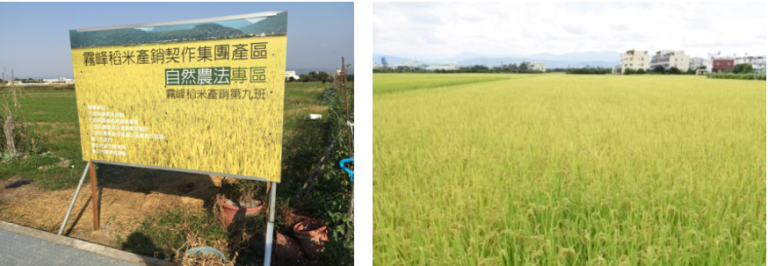
Detailed description of Activities
The Farmers’ association guides the planting of new varieties of rice and stabilizes income
In Taiwan, two phases of rice cultivation can be conducted each year. The first phase runs from February to June, and the second phase runs from July to November. Since the first phase of rice production in 2002, the Wu Feng District Farmers’ Association has conducted industry-university cooperation with the Taiwan Agricultural Research Institute. The subordinate institution of the Council of Agriculture, Executive Yuan, provides technical guidance to the farmers’ association to promote the “Wufeng aromatic rice”, a locally produced brand of Tainung 71 rice. The promotion provides an opportunity for the rice industry to transform. To ensure the quality of aromatic rice, the Wu Feng Farmers’ Association proactively encourages the establishment of rice production and marketing groups. Under this system, rice cultivation is operated under cooperative contract farming, with regular field inspections and strict control of pesticide and fertilizer utilization; thus, the rice’s quality and special taro aroma are ensured. There are also large-scale investments in computerized control of the drying and low-temperature storage process of rice. At the same time, four-channel color sorters have been imported from Japan to remove impurities. The “Wu Feng aromatic rice” brand has been established, while with contracted farming and purchase, the producers’ revenues are stabilized, and the farmers can produce rice of higher quality.
The contracted farming area in 2002 was about 7 ha, and the price was 21 NTD per kilogram, calculated based on the dry grain (the available purchase price in other parts of Taiwan was about 18 NTD per kilogram). As the farmers’ income has stabilized, the number of farmers who participate in the cultivation of new rice varieties and technical guidance organized by the Wu Feng District Farmers’ Association has increased year by year, and the cultivated area has also expanded year by year. By 2020, the contracted rice cultivation area was about 267 ha in each phase, and the yield is about 1,555 metric tons, accounting for about 23% of the whole paddy rice production area in the Wu Feng District at the moment. The program has contributed significantly to developing local rice production and stabilizing the revenues of rural households (Huang et al., 2020).

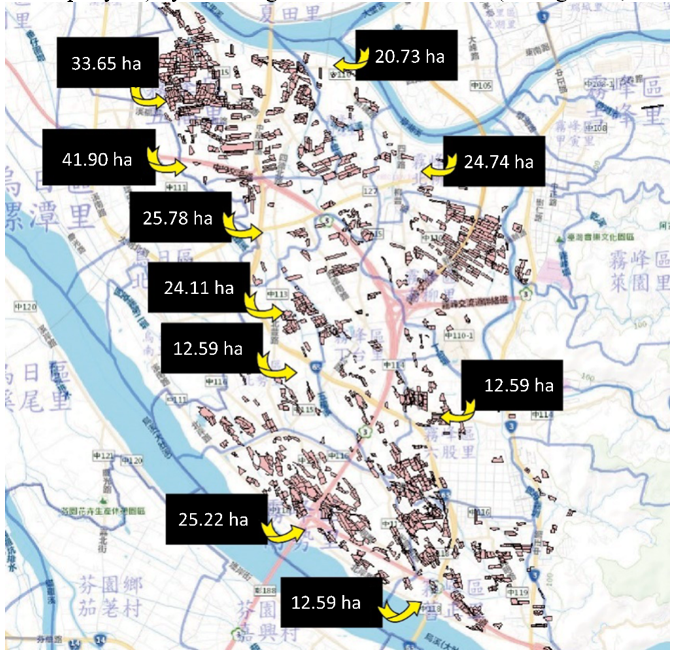
Using the Black-winged Kite as an indicator species for the farmland ecosystem health in Wu Feng District and continuing to adopt organic farming to maintain the biological habitats
Birds are often regarded as Indicator organisms in an ecosystem. The main reasons include the following: (1) Bird ecology has been studied extensively; (2) There is a close relationship between birds and their habitats; (3) Different birds occupy varied trophic levels and are mainly at the higher levels of the food web; (4) Birds are accessible to observed. Raptors occupy a high trophic level in the food web and are often regarded as an indicator species, which can help evaluate whether an ecosystem is healthy. In addition, the living area of a raptor is vast. Therefore, by monitoring the behavior of raptors, we can obtain environmental information accumulated in the food web and indirectly understand the integrity and complexity of the local ecology. In terms of conservation, raptors are often regarded as umbrella species. By protecting raptors, vast areas of habitats and other species can be saved. In Taiwan, wilderness raptors usually live within grass savannas with wide spaces or vast farmland areas. Small mammals, such as rodents, are their main primary sources. Occasionally, they prey on birds, reptiles, and invertebrates. In Taiwan, most raptors who prefer grasslands as their primary habitat are migratory species, such as Black Kite (Milvus migrans). Still, Black-winged Kite (Elanus caeruleus) is the only breeding diurnal raptor that mainly occupies grasslands.
Black-winged Kites were first observed in the rice cultivation area of the Wu Feng District in 2010. The Black-winged Kite is a resident bird of Taiwan, which feeds mainly on small mammals and catches plains vizcacha rats (Tympanoctomys barrerae) such as the Taiwanese gray shrew (Crocidura tanakae), Lesser white-toothed shrew (Crocidura suaveolens), Asian house shrew (Suncus murinus), Lesser ricefield rat (Rattus losea), House mouse (Mus musculus) (BalbontÍn et al., 2008; Manaa et al., 2013). As the Black-winged Kite is a rodent-eating raptor, it can be observed on the plains all year round. It plays a vital role in the rodent control of Taiwanese farmland and indirectly benefits agricultural production by reducing the use of poisonous rodenticides and promoting organic agriculture.
According to the list of protected wildlife species issued by the Council of Agriculture, Executive Yuan, following the Wildlife Conservation Act, the species can be divided into three levels based on the size of the populations and conservation status. Among them, the Black-winged Kite belongs to the second level, which is a “valuable and rare protected animal”. It usually lives in habitats located at an altitude from 75 m to 2,000 m and is active in open grounds, farmland, and grassland. It usually stays in high places that can be easily observed, nests on trees with dense branches and leaves, and away from human activities’ interference. It is a diurnal raptor that prefers to move in areas away from the sun. During the breeding season, the male birds are responsible for foraging and repelling enemies, while the female birds are responsible for incubation and feeding nestlings. Foraging and feeding behavior, the Black-winged Kite raptor likes to sit, wait, and search while flying. It usually forages in cultivated farmland or marginal areas with patches of fallow fields, and it mainly preys on rodents. The Black-winged Kite has two annual breeding periods, in summer and autumn. During the summer breeding period (March and April), there are more nest sites, and more young birds typically hatch (an average of four hatchlings), whereas fewer nest sites for breeding in autumn results in fewer hatchlings (Taichung Branch of the Soil and Water Conservation Bureau, 2020).

Under the guidance of the Taichung Branch of the Soil and Water Conservation Bureau and the Wu Feng Farmers’ Association, farmers gradually began to change their farming methods in 2014. However, rodent infestation in the eco-friendly fields was a severe challenge. The rodents would burrow in the ridges and cause the areas to lose water. Further, the rodents would eat the rice plants from the roots and die. The Black-winged Kite is one of the raptors in Taiwan that inhabits farmland. It feeds on rodents and plays a key role in the biological control of rodents. It controls the numbers of harmful rodents and pests that endanger agricultural production, which is constructive to the development of sustainable agriculture, while this habit of the Black-winged Kite helps to reach the goal of conserving raptors at the same time. The food habit of the Black-winged Kite varies with the availability of prey, habitats, and seasons. Food habit is a critical factor in looking for strategies for managing and conserving the Black-winged Kite population. Therefore, the Ninth Production and Marketing Group of Wu Feng rice in the Wufu Community started eco-friendly farming in 2015 under the guidance of the Wu Feng District Farmers’ Association. This group farmed without using chemical fertilizers and pesticides and transformed the way of growing rice by changing the farming habits of farmers. In 2017, the Taichung Branch of the Soil and Water Conservation Bureau, the Wu Feng District Farmers’ Association, the Institute of Wildlife Conservation at National Pingtung University of Science and Technology (NPUST), and an ecological observer, Jing-Hong Lee joined together to set up bamboo perches in the fields to provide more places for the Black-winged Kites to stay and induce them to prey on the rodents in the areas. Automatic infrared cameras observed the ecology on and surrounding the perches. The birds that use the perches appear to be the Eurasian Tree Sparrow (Passer montanus), Light-vented Bulbul (Pycnonotus sinensis), Brown Shrike (Lanius cristatus), Red Collared-Dove (Streptopelia tranquebarica), Black Drongo (Dicrurus macrocercus), Gray Treepie (Dendrocitta formosae), Savanna Nightjar (Caprimulgus affinis), Chestnut-tailed Starling (Sturnia malabarica), Black-collared Starling (Gracupica nigricollis), Zitting Cisticola (Cisticola juncidis), Javan Myna (Acridotheres javanicus), Common Myna (Acridotheres tristis), Black-winged Kite, and Eurasian Kestrel. The Black-winged Kite is the major raptor that uses the perches to prey on rodents. The birds that prey on invertebrates include the Black Drongo and the Brown Shrike, while the birds that use the perches for mating include the Black-winged Kite and Zitting Cisticola.
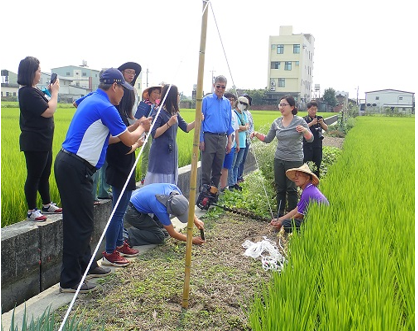
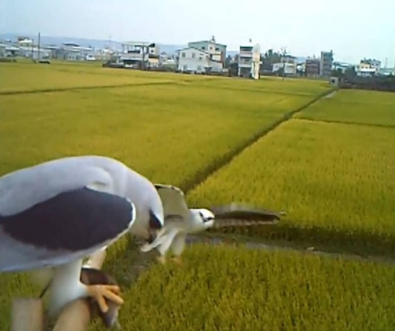
(Image source: Taichung Branch, Soil and Water Conservation Bureau, COA, 2020)
Using the GPS, the NPUST tracked the movements of Black-winged Kites. It has been found that the kites lived within an area of 1.6 square km, and the habitat compositions within the range include night-roosting on trees in river highlands, roosting and nesting in forests or on trees next to fields, and roosting and foraging on perches. The continuous monitoring by automatic infrared cameras recorded that during the 35 days from September 28 to November 2, 2018, two Black-winged Kites captured a total of 67 rodents, five sparrows, two red collared doves, and Brown Shrikes. The captured rodents include two species, namely the striped field mouse and the Ryukyu mouse. Under the perches (which are not monitored by automatic cameras), the pellets of the Black-winged Kites, eaten rodents, and sparrows’ remains were found, indicating that it is adequate to use Black-winged Kites as a means to control rodents in fields. A pair of Black-winged Kites can prey on an average of about two rodents daily. Six rodents were caught between 3:50 pm and 5:30 pm, but only two of the rodents had stood in front of the automatic camera. The result demonstrates that the number of rodents captured (recorded by the robotic camera) is lower than the number caught. That is, the daily captured rodents by Black-winged Kites might be higher than two, and the effect of preventing and controlling rodents by Black-winged Kites is incredibly significant.
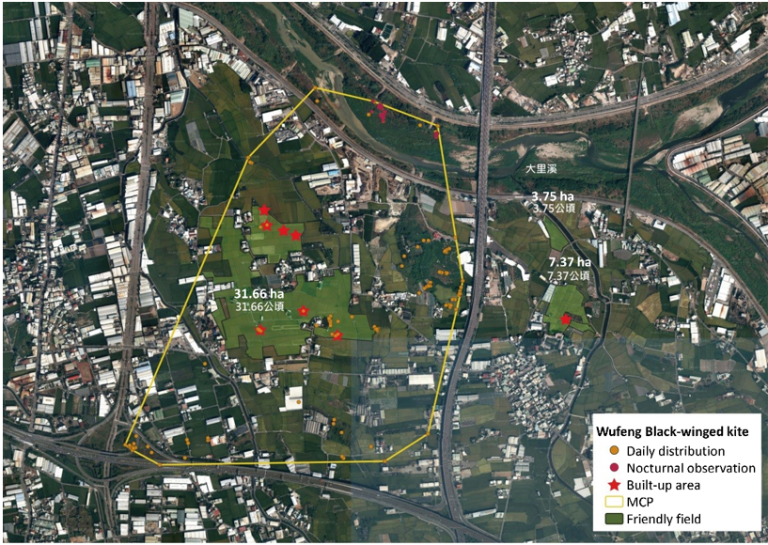
Establishing a verification mechanism for the production of organic rice through the industry-university cooperation between the farmers’ association and National Chung Hsing University
The Council of Agriculture and National Chung Hsing University (NCHU) have established the Organic Agriculture Promotion Center, the Agricultural Product Pesticide Residue Analysis Center, and the Agricultural Products Approval and Certification Center. The NCHU Mart sells the product of the College of Agricultural and Natural Resources, and organic farmers markets, assisting the governments of counties/cities and the farmers’ associations to promote eco-friendly and organic agriculture. The Organic Agriculture Promotion Center was established in 2019 at NCHU following the Organic Agriculture Promotion Act. The center assists farmers and farmers’ associations in solving problems faced by agricultural production. Due to the proximity of the Wu Feng District Farmers’ Association to NCHU, the two have developed into long-term partners and agreed to set up a project promotion center in September 2021 to assist the administrative departments in formulating promotion plans for organic agriculture, providing research support and professional education services. The center is responsible for supporting the formulation of measures every four years by providing reference information and effectiveness evaluation to promote the development of organic agriculture and guidance to the development plan of Wu Feng organic rice. The NCHU Agricultural Product Approval and Certification Center was established in 2007 by the Agricultural Production and Certification Act. The center follows the Product Verification Agency Certification Standards, ISO/IEC 17065, the Agricultural Production and Certification Act and related sub-laws, the Organic Agriculture Promotion Act and related sub-laws, as well as the related laws and regulations stipulated by the Council of Agriculture. The center focuses on the certification of agricultural food products, management of the organic cultivation of agricultural food crops, planning of the food traceability system, and training agricultural food product auditors and safety management personnel. The center assists the Wu Feng District Farmers’ Association in managing and planning the production records for traceability of eco-friendly and organic rice cultivation. The National Chung Hsing University, Agricultural Product Pesticide Residue Analysis Center, conducts safety testing to monitor the number of pesticide residues in agricultural products to maintain the quality of food hygiene, enhance the market competitiveness of farm products, and protect the rights and interests of farmers and consumers. The NCHU Agricultural Product Pesticide Residue Analysis Center was established under the Act Governing Food Safety and Sanitation to teach farmers about safe and professional drug use, improve crop quality, and maintain agricultural product safety. The center further conducts pesticide residue tests on the rice produced in the Wu Feng District to confirm the quality of rice and that no pesticides are used on it illegally.
The NCHU Mart that sells the product of the College of Agricultural and Natural Resources is set up to fulfill the goals of research, teaching, and service concurrently. Agricultural and related products with the characteristics of the university are invented under the brand name of NCHU to set up an exhibition and sale platform that combines teaching, internship, production, quality control, and marketing. The Wu Feng District Farmers’ Association cooperates with the NCHU Mart to set up a Taichung special agricultural product counter in the mart to sell special agricultural products, including organic, eco-friendly, and traceable products from the? Farmers’ associations in Taichung and the top 100 premium agricultural products from the Farmer’s and Fishermen’s Association. The NCHU Organic Farmers Market consists of 30 stalls and is open every Saturday from 8:00 am to 12:00 pm. The market was set up to help disadvantaged smallholder farmers through the promotion of local production and local consumption. The National Chung Hsing University’s supervision and certification can boost consumers’ confidence in the products. At the same time, the community members can learn more about organic farming by trading at the farmer’s market. Agricultural products must obtain an organic certification issued by the certification agencies before selling them at the farmer’s market. Currently, most farms sell products certified by the MOA International, Tse-Xin Organic Agriculture Foundation (TOAF/TOC), the National Chung Hsing University, and Taiwan Organic Production Association (TOPA) in the farmer’s market. To protect the rights and interests of the consumers, inspection agencies, such as the Liu-Kung Agriculture Foundation, Taipei, are invited to the farmer’s market on an irregular basis to conduct pesticide residue tests on the products sold in the market to ensure the safety of agricultural products. Farmers who adopt organic farming in the Wu Feng District are welcome to join in and sell organic agricultural products.
The enterprises support Farmers’ associations and adopt rice in organic fields
The Wu Feng District Farmers’ Association facilitates the cooperative group contract farming zones of rice producers and merchants, in which farmers adopt eco-adopted friendly and organic farming methods. Paddy rice is grown in the zones with pesticide and chemical-free methods, and the strategy has been proved successful. The Wu Feng District Farmers’ Association has further expanded the eco-friendly farming method and implemented the “Rehabilitation Program for Every Household’s Farmland” in 2017. Each local enterprise that joins the program can financially support a designated field and build trust with the farmers in the course of cooperation. As the enterprises support the farmers by providing financial security, the farmers can supply rice that is sure to be safe and healthy for the enterprises. Through the program, the enterprises can practice social responsibility and improve their corporate images on the one hand while improving the ecology on the other hand, as the simple and pure rural environment in the past can be rehabilitated. The future generations can enjoy a better environment. During the process, an enterprise can support the production of the current or the next phase of rice cultivation, with the phases being divided by each harvesting period. The basic unit of support is 0.1 ha, and the total number of units of supported rice cultivation is 30 units. The amount is 38,000 NTD per unit (0.1 ha).
Establishing the “Black-winged Kite” brand of rice
In August 2019, the Wu Feng District Farmers’ Association launched the “Black-winged Kite rice,” made from Yichuan aromatic rice grown on eco-friendly farms. About 10,000 packs of rice are sold annually, promoting the concept of controlling rodents by Black-winged Kites in all regions of Taiwan. One hundred packs of Black-winged Kite rice were donated for charity sale, and the proceeds were used for research at the NPUST. The Black-winged Kite rice donated to charity was sold out after three days, showing that the public fully recognizes and supports eco-friendly products. In later days, the Black-winged Kite rice had been sold through the marketing channels of the National Farmers’ Association of Taiwan, the premium agricultural goods sale channel of the Soil and Water Conservation Bureau, the NCHU Mart, the direct selling stores set up by the Wu Feng District Farmers’ Association, and farmer markets, which are especially popular among consumers.
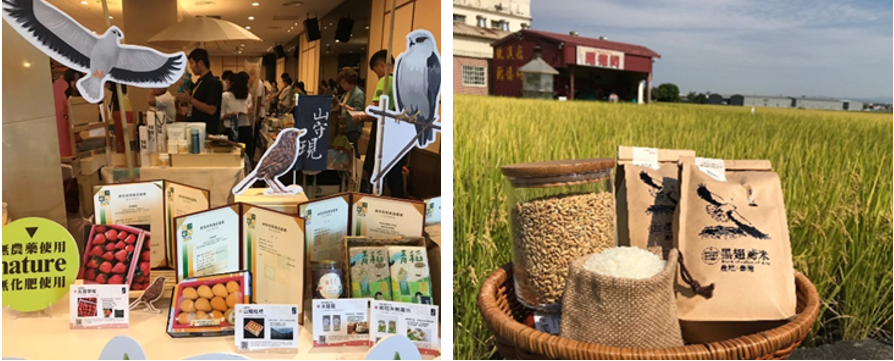
Opening a distillery to produce rice wines
To address the potential problem of an overproduction of rice, prevent spoilage due to an excessive time of storage, and increase the economic value of rice products, the Wu Feng Farmer’s Association Distiller dispatched the first batch of winemakers to the Niigata Prefecture of Japan in 2006, to learn about sake brewing. Since then, Tainung 71 rice grown in the Wu Feng district has been used to make wine. The fine wine, Initial Fog Shochu, made from Yichuan aromatic rice, has been awarded both gold and silver medals at the Germany-based International Spirits Award and Brussel-based Concours Mondial Bruxelles from 2010 to 2015. In contrast, the Initial Fog Junmai Daiginjo (Pure Rice Wine) has been awarded gold and silver medals by international wine competitions based in Germany and France from 2011 to 2015. In addition to aromatic rice, lychees and honey are important agricultural products from the Wu Feng District. Litchi Mead, distilled by the Wu Feng District Farmers’ Association, was awarded a gold medal at the Concours Mondial de Bruxelles – Spirits Selection in 2014 (Chen, 2018).
Results
Successfully facilitating the reproduction of Black-winged Kites and changing farmers’ behavior in organic farming and protecting animals
Due to the rapid disappearance, fragmentation, and simplification of the habitats of raptors, coupled with over-hunting and environmental pollution, the populations of raptors are threatened. Previously, the use of chemical agents for pest control in fields had harmed raptors at the top of the food web. The conflicts between raptors and farmers have also threatened the survivorship of the raptors. Thus, the raptor populations are declining with the development of the environment. Some species have adapted to the changing climate, but the vast majority of raptors are facing extinction, among which the Black-winged Kite is an example.
In the Wu Feng District, the Soil and Water Conservation Bureau and the NPUST joined to monitor the reproduction of the Black-winged Kites. In 2018, researchers found that some Black-winged Kites nested on a betel tree next to a field and successfully bred three Black-winged Kite nestlings. In February 2019, successful breeding juveniles dispersed to other eco-friendly fields. It shows that the habitat environment is suitable for the Black-winged Kites for foraging and reproduction, which is highly important for conserving Black-winged Kites. The farmers have participated in monitoring the reproduction of Black-winged Kites and helped observe the process of nesting, incubating, and raising young. They also patrol the nest area to deter people from interfering and destructing. From 2010 to 2017, the farmers continued to learn and participate in observing and recording the Black-winged Kites, so their concepts and practices related to the conservation of Black-winged Kites have gradually changed. The major changes include:
- Farmers have become aware of the Black-winged Kites in field areas Since the project of setting up perches to attract Black-winged Kites to control rodents in fields started in 2018, the areas carry the functions of production and ecology concurrently. This is also the first successful case of using Black-winged Kites for biological control in Taiwan. The farmers welcome the results and even start to patrol and pay attention to the time and frequency of the appearances of Black-winged Kites. They also pay attention to environmental conservation in the fields, such as persuading fellow farmers nearby to reduce the use of pesticides.
- Spontaneously creating a predation environment for Black-winged Kites. Farmers will use the ridges or open space to grow vegetables, preserving the landscape and improving ecological value. Farmers said planting root and stem vegetables, such as radishes and sweet potatoes, will attract rats to the fields. This action will mitigate rodent damage and raise the raptors’ attack success rate.
- More farmers participate in expanding the area of eco-friendly fields. The total area was expanded from 5 ha to 78.28 ha between 2015 and 2020. Accordingly, 6.42 ha have received organic certifications, while 49 ha have been transformed into organic farms.
- The Soil and Water Conservation Bureau assists in the promotion of perch setting techniques, expanding the benefits of ecological control.
The setting up of perches is conducive to attracting Black-winged Kites to control rodents in fields, and the farmers have recognized the results. When the program started, only one location (Wufu Village) had set up the perches. Afterward, three surrounding villages (Liugu Village, Dingtai Village, and Nanshi Village) set up perches, and the practice of biological control was shared. From this experience, the principles of selecting the location of the perches have been summarized. The perches should be more than 50 meters away from trees, telegraph poles, and other high objects to achieve the effect of roosting and staying. The perches should be away from roads, homes, and factories to reduce the interference of people and vehicles; the material, height, and form of the perches should be adjustable, with an altitude between 4-9 meters, depending on the landscape composition of the surrounding area, so that the perches can become the highest points of the regions. Farmers in the Longjing District affirmed the successful experience of the Wu Feng District. On June 26, 2019, a class that taught how to set up perches in the fields was held in the district. The Longjing District Farmers’ Association then taught the technique to the production and marketing groups and set up perches in the areas that grow Siaoyu watermelon. The predation and mating of Black-winged Kites have been recorded, while the predation of collared scops owls at night, in which they flew to the ground with the perches’ help, has also been recorded four times.
The Black-winged Kite brand raises the price of rice products and increases farmers’ income
The price for 1 kg of Yichuan aromatic rice is 62 NTD, while the price for 1 kg of Black-winged Kite rice is 180 NTD, 2.9 times that of ordinary Yichuan aromatic rice. This demonstrates that the added-ecological value of Black-winged Kite rice can effectively increase product prices. Apart from this, it is estimated that 1 kg of Yichuan aromatic rice can be made into 700ml of Black Wing Kite Wine (Drunk Peak), selling for a price of 1,280 NTD. Regardless of the equipment and other costs, the price is 20.65 times that of ordinary Yichuan aromatic rice. This shows that using Yichuan aromatic rice to make Black Wing Kite Wine can significantly increase the economic value of rice.
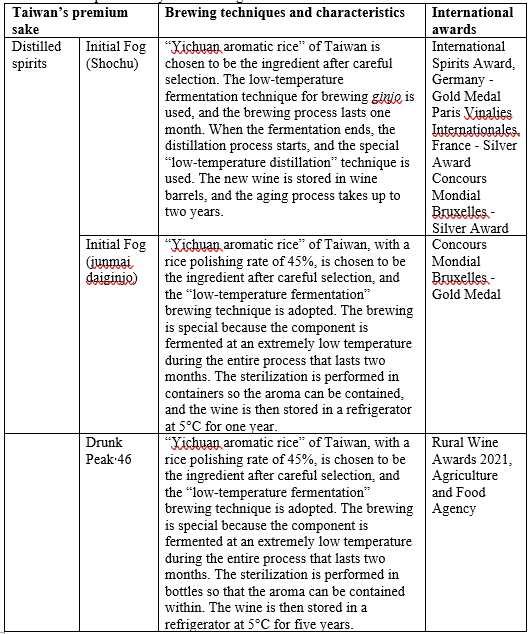
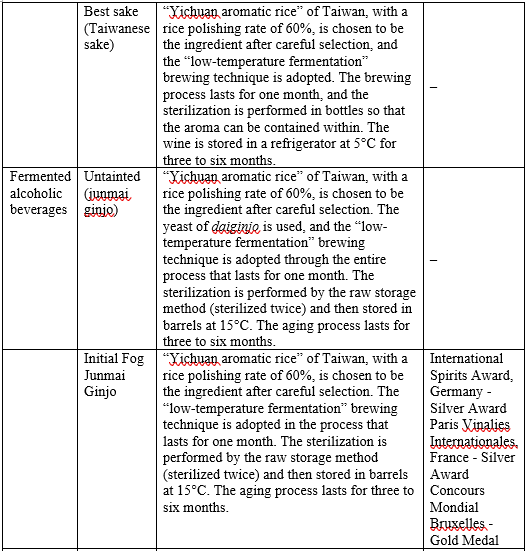
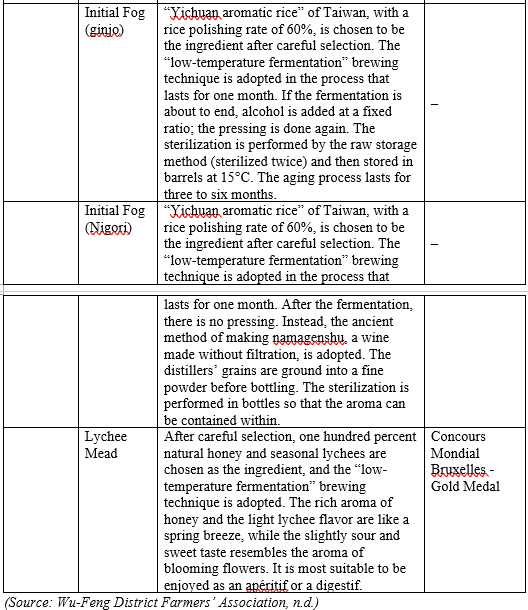
The support of farmers’ associations for agricultural development and farmers’ welfare
Farmers in Wu Feng District face financial, production, and marketing problems in agricultural operations. From the farmers’ standpoint, the above three issues reflect one integrated problem. Therefore, a farmers’ association should consider the difficulties in its operations. Based on this viewpoint, the associations in Taiwan are set up as a type of farmers’ cooperative organizations with multi-functions and multi-purposes to realize the planned and integral cooperation between the departments of promotion, credit, and supply and marketing, so that they are mutually supportive. The products produced by farmers are sent to a farmers’ association for joint transportation and marketing so they can be sold at higher prices. At a farmers’ association, the materials needed for production and daily necessities of higher quality are provided at a lower price, increasing the farmers’ savings. The farmers’ association can collect deposits from members and use part of the deposits as operational funds to handle the supply and marketing business. A more significant amount of capital investment is usually needed to modernize farming methods. The credit department can provide sufficient funds with reasonable interest rates promptly for the farmers to purchase various production materials and engage in production. The surplus of the supply and marketing credit department and the credit department can be allocated to promotional activities. Promoters are dispatched to rural villages to introduce new, high-quality varieties of crops to the farmers and provide further education. As a result, the farmers’ income will increase. They will have more capital to be used for investment. At the same time, their confidence in the farmers’ associations will be strengthened so that their willingness to participate in the farmers’ association’s supply and marketing business and credit business will increase.
In summary, the promotion, supply and marketing, and credit businesses of the farmers’ associations are mutually supportive. The strengthening of promotional service work can increase the farmers’ confidence in the farmers’ association. When a farmer’s confidence in the farmers’ association is increased, they will feel at ease to deposit in the credit department of the farmers’ association. The farmers’ association can use the deposits as loan funds and funds to develop supply and marketing businesses to serve the members better. The surplus of the supply and marketing credit department and the credit department can be allocated to expand promotional activities and help the farmer members strengthen their confidence in the farmers’ association. The three departments become mutually supportive (Liu, 1999).
Lessons learned
The landscape-industry-biological-friendly relationship in farmland based on farmers’ beliefs
Based on the confidence in organic agriculture, the farmers in the Wu Feng District implemented organic farming methods in the rice production fields, thereby building a friendly relationship between farmers, farmland, and biological species. The primary key is the change in the farmers’ consciousness due to the promotion and education provided by the Agriculture Research Institute and the farmers’ association. Their methods of paddy rice farming have changed from conventional agriculture to eco-friendly farming and organic farming. During the process, their fields were successively infested by rats, moths, and diseases, causing problems such as water loss and reduced yields. With the help of the farmers’ association, the Agriculture Research Institute, and the National Chung Hsing University, they have overcome the problems one by one. With the changes in rice farming methods and the dispersal pattern of Black-winged Kites, the issue of rodent damage has been alleviated, and the farmers’ perception of Black-winged Kites has been improved (Taichung Branch of the Soil and Water Conservation Bureau, 2020). They stopped hunting the raptors and turned to conservation to maintain the ecological balance of the fields and rebuild the environmental system of the organic rice field zones. The ecosystem restoration has also benefited rice production, improving the quality, yields, and prices, ultimately increasing the farmers’ income.
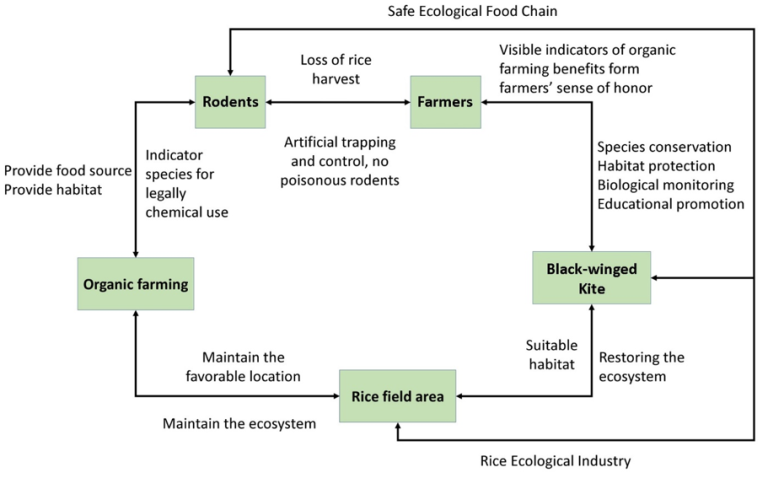
The ecological industry, based on consumer recognition, promotes the balance between regional environmental conservation and agricultural economic prospects
Taiwan has been promoting organic farming methods since 1999. The area of organic farming has increased from 821 ha (in 1999) to 8,759 ha (in 2018), which saw an increase of 7,938 ha and a 10.69-fold expansion over 20 years, demonstrating that consumers have more confidence in organic agriculture and organic agricultural products as time goes on. Since 2018, an Organic Agriculture Promotion Act has been implemented in Taiwan. In October 2020, farmlands that have adopted organic farming reached 10,573 ha. If the eco-friendly farmland is also counted, the area reaches 15,411 ha, accounting for approximately 1.95% of Taiwan’s agricultural land. The improvement indicates that consumers have accepted organic products and that consumption of organic products is gradually increasing.
While organic farming increases yearly, the ecological habitats in Taiwan’s farmland have also gradually improved. There are sufficient habitats, activity spaces, and food sources for the indicator species of the farmland ecosystem (such as raptors and mammals) to return to the fields. Several eco-agricultural products have been widely accepted by consumers so that the farmers can earn a higher income. Examples include “Guantian pheasant-tailed jacana water caltrop” product produced in fields that allows the symbiosis of Pheasant-tailed Jacana (Hydrophasianus chirurgus) and Water Chestnut (Trapa natans L.); the “leopard cat rice” produced in organic paddy rice fields, which protects the habitats of leopard cats; and the “giant water bug rice” which covers the Lethocerus deyrollei (a species of giant water bug). The programs appear to increase the farmers’ willingness to protect the unique biological species in the fields, such as the Black-winged Kite.
Based on the experience in the development of ecological agricultural products in Taiwan, and the support of consumers for environmental agricultural products, the Wu Feng District Farmers’ Association has abandoned the methods of protecting farmland habitats in small areas, and adopted large-scale, contracted organic cultivation in fields with the organizational strength of the farmers’ association. This practice is conducive to protecting the Black-winged Kites’ habitats and the continuous reproduction of the population of the raptors. The effect can be extended to the surrounding areas so that the region can become a fountain of reproduction of the people, helping to slow the extinction of the species. In addition, large-scale area cultivation can achieve the advantage of economies of scale. Coupled with the marketing organized by farmers’ associations, the farmers’ direct income has increased. From the perspective of the farmers’ association, the value created by making high-quality sake from organic rice is much higher than the price of rice, generating higher economic benefits for the farmers’ association. Under the regulations of the Farmers Association Act, part of the revenue should be returned to the farmers, once again increasing the farmers’ income.
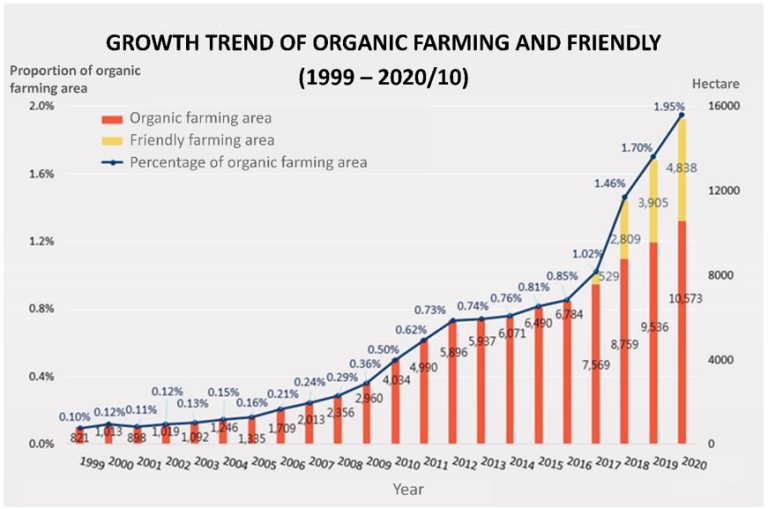
The successful transformation of the rice industry and the development of a regional ecological industry chain of rice made possible by cross-discipline cooperation
For a long time, rice has been the most important crop in Taiwan. Taking the first phase of rice production in 2021 as an example, the total rice paddy was 127,374.63 ha, and the output reached 771,320.422 metric tons. The amount of rice produced in western Taiwan is enormous, while the product differentiation is low. Furthermore, the market is saturated. Most regions are reducing costs and increasing production, and, as a result, rice prices in most areas are not high. Therefore, innovations in crop varieties, production environments, and processing technologies are necessary to extend the life cycle or revive the rice industry that has entered a mature or declining period.
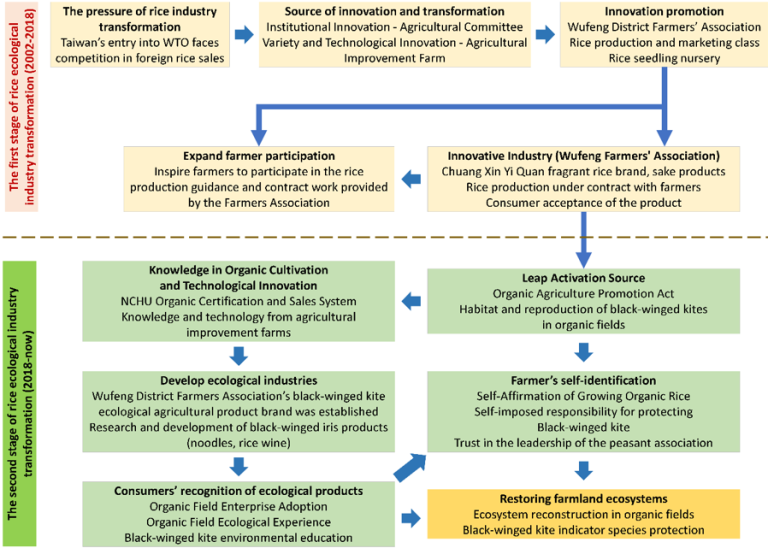
The Wu Feng District Farmers’ Association performed the first rice industry transformation from 2002 to 2015, mainly due to Taiwan’s accession to the World Trade Organization (WTO) in 2002. The rice industry faces competition from imported rice, and innovative transformation is necessary to extend the industry’s life cycle and allow farmers to maintain a stable situation. The change in the rice industry is mainly pushed forward by the innovation of rice varieties, production technology, and processing technology. Rice varieties are created primarily by having the farmers switch from growing Japonica rice and Indica rice to growing Tainung 71 (Yichuan aromatic rice). The rice plants of this variety have moderate and long-lasting resistance to most diseases and invertebrate pests. The harvested rice grains are short and round, with a glistening look. When cooked, the rice turns into a glutinous and pleasantly chewy mass and has a strong flavor similar to taro. The production technology innovation is mainly realized by introducing the cultivation technology of Tainung 71. Production technology innovation is primarily recognized for producing high-quality sake with Tainung 71 rice.
A study by Huang et al. in 2011 noted various factors for this success. Firstly, the farmers’ association has applied this rice breeding improvement technology (from the rice research unit of the Agricultural Research Institute) to the paddy rice improvement fields in Taiwan. Together with the farmers’ planting experience, this new technology research and rice production technology have been completely integrated. The farmers form agricultural groups by themselves to compare and verify the latest technology by comparing it to traditional planting concepts and exchanging planting experiences. Secondly, the Agricultural Research Institute provides new varieties and technologies. At the same time, the Wu Feng District Farmers’ Association invests in computerized equipment to control the strict production processes, including rice drying, low-temperature storage, and impurity removal. The rice variety has also entered the Japanese market at a high price after being promoted at the World Exposition Aichi Japan. It has become Taiwan’s most competitive variety of rice since joining the WTO. Thirdly, the farmers’ association guides the farmers in entering contracts. For example, as the farmers enter production contracts with the farmers’ association, they are trained to produce high-quality aromatic rice. During the process, they must conduct regular field inspections and strictly control the agriculture methods and fertilizers to ensure product quality. Fourthly, an agricultural product traceability system has been established. Therefore, the farmers must report the production process in detail and convert their personal rice production experience into standardized and corporatization production methods. The consumers then can understand the production process and develop a sense of trust and loyalty to the product. Fifthly, the value of rice has expanded. For example, a distillery was established to raise the value chain of the rice industry and create wine products made from rice (Huang et al., 2011).
The foremost opportunity for the second transformation lies in the rise of eco-friendly and organic rice farming. Since 2012, the area of eco-friendly rice farming across Taiwan has increased significantly, while new products that feature eco-friendly or organic rice farming have appeared on the market. Realizing the development trend, the Wu Feng District Farmers’ Association initiated the transformation of rice production and processing methods. Since 2015, with the help of the Agricultural Research Institute, the farmers’ association has guided the farmers to farm in an eco-friendly way. The farmers’ association also encourages the enterprises to financially support rice production (Rehabilitation Program for Every Household’s Farmland) to build an environment-friendly brand image for Yichuan aromatic rice. The government has provided resources under the 2018 Organic Agriculture Promotion Act, while agricultural research units have developed organic agricultural production technologies. NCHU has been subsidized to establish centers providing production guidance, inspection, and verification mechanisms of organic farm products. Farmers’ association, Taichung City Government, and NCHU have jointly established sales channels for organic rice to accelerate the transformation of organic rice products by the District Farmers’ Association in Wu Feng. The Black-winged Kite was found in organic fields in 2017 and induced the farmers’ association to develop rice products that feature the protection of biological species. The complete ecological observations and records of the Soil and Water Conservation Bureau have confirmed that the raptor contributes significantly to rodent control in the fields; the farmers have widely accepted the concept of protecting Black-winged Kites. Black-winged Kite rice, the ecological rice product proposed by the farmers’ association, has considerably enhanced the brand image of Yichuan aromatic rice. In contrast, rice-related products such as Black-winged Kite noodles and Black-winged Kite wine have been further developed and are popular among consumers.
There are various key factors for the success of the second transformation. Firstly, the completed industrial chain and production operation mechanism has been established during the first transformation, which provides a good foundation for development. Secondly, farmers have a high degree of trust in the association. 65 farmers from the Wu Feng District discussed their reasons for participating in the rice production programs of the farmers’ association. The key reasons for joining included the sense of honor that comes with the contracted production of rice with the farmers’ association and their high degree of recognition of environmental sustainability. They also appreciated the strict requirements for production management of the farmers’ association and its efforts in ensuring the benefits of contracted farmers, making them willing to participate continuously. Thirdly, the Black-winged Kite has enriched the ecological connotation of rice production and turned it into an exciting story, which is highly conducive to marketing and promoting related products (Taichung Branch of the Soil and Water Conservation Bureau, 2020). Fourthly, the decrees and investments of the government have encouraged the establishment of the standardized production, processing sales, and certification of organic agricultural products, which have enhanced consumers’ trust in organic products (Huang et al., 2020).
Organic rice production plays a role in reducing carbon emissions
In 2010, Wu and Lur conducted an environmental impact assessment of rice production’s life cycle and carbon footprint. The results showed that for each kg of white rice produced in Taiwan, 2.78 kg of carbon dioxide equivalent would be emitted (Wu & Lur, 2010). Since the annual output of rice in the Wu Feng District is about 13,000 metric tons, this implies about 36,140 metric tons of carbon dioxide are emitted. If the emissions from milling, transportation, packaging, and cooking are counted, the amount would be even more tremendous. In 2009, the Environmental Protection Administration discussed establishing a carbon footprint label to mark the number of carbon emissions on the outer packaging of products. This would allow consumers to understand the carbon emissions generated during the life cycle (collection of raw material, manufacturing, transportation, use, and disposal) of the products and use this as a reference when consuming and purchasing products. For Tainung 71 rice, the carbon footprint generated from the stages of cultivation, milling, transportation, packaging, and disposal has been inspected since 2012. The product gained the carbon footprint label certificate issued by the Environmental Protection Administration in 2013, which is the first carbon footprint label for rice products in Taiwan. The carbon footprint label has been printed on the outer package of the rice product. 83% of the respondents had purchased Wu Feng aromatic rice. The reasons they provided for choosing Wu Feng aromatic rice included the excellent taste of the rice and the aroma of the rice. The carbon label obtained by Wu Feng aromatic rice shows that the industry operators value energy saving and carbon reduction, and 41% of the respondents reported that they would buy the product more often because of the carbon label. Nearly 82% of respondents who had bought Wu Feng aromatic rice were willing to recommend the product, which carries a carbon label, to their relatives and friends. The above analysis shows that consumers who love Wu Feng aromatic rice overwhelmingly support carbon labels. Regarding willingness to pay, 79% of respondents stated that they were willing to pay more for the Wu Feng aromatic rice with carbon labels, and they were willing to pay 10 NTD more for each pack (65%). It can be seen that carbon labeling has a positive effect on the promotion of Wu Feng aromatic rice, and the respondents were also willing to buy the rice at a higher price, which shows their determination to support carbon reduction.
Key messages
- The successful results in encouraging the reproduction of Black-winged Kites have changed the farmers’ behavior in organic farming and increased wildlife protection.
- Based on consumer recognition, the ecological industry has promoted the balance between local biodiversity conservation and agricultural economic prospects.
- The successful transformation of the rice industry and the development of a local ecological industry chain of rice has been made possible by cross-discipline cooperation.
- Organic rice production plays a key role in reducing carbon emissions.
Acknowledgements
The authors would like to warmly thank the Soil and Water Conservation Bureau in Taiwan for funding support. We also thank Ms. Hui-Shan Lin, Mr. Jing-Hong Lee, and Mr. Jian-An Ma help with Black-winged Kites and rice production on-site survey.
References
Agriculture and Food Agency (n.d). Taiwan Organic Agriculture System, Council of Agriculture, Executive Yuan, ROC (Chinese Taipei), viewed 02 July 2022 <https://epv.afa.gov.tw/#gsc.tab=0?
BalbontÍn, J., Negro, J. J., Sarasola, J. H., Ferrero, J. J., & Rivera, D. (2008). Land-use changes may explain the recent range expansion of the Black-shouldered Kite Elanus caeruleus in southern Europe. Ibis, 150(4), 707-716. https://doi.org/10.1111/j.1474-919X.2008.00845.x
Chen, C.-W. (2018). Winemaking Plant Tour. Country road, 44(8), 82-83. https://doi.org/10.6707/agri.201808_44(8).0025
Chen, H.-S., & Shyu, T.-H. (2019). Analytical Method for the Determination of Residual Anticoagulant Rodenticides in Raptorial Bird Livers. Taiwan Pesticide Science(6), 105-117. https://doi.org/10.6671/TPS.201906_(6).05
Environmental Protection Administration (n.d). Background to Taiwan CFP-Labeling and CFP-Reduction Labeling. Environmental Protection Administration, ROC (Chinese Taipei), viewed 21 June 2022, https://cfp-calculate.tw/cfpc/Carbon/WebPage/Background.aspx.
Huang, C. C., Chi, S.-Y., & Chien, L.-H. (2020). An Analysis of the Intention of Farmers’ Participation in Organizing Contracts – A Case of Yihchuan Aromatic Rice Farming Contract of Farmers’ Association in Wu Feng District. Journal of Agriculture and Forestry, 67(3), 195-206.
Huang, C.-Y., Chang, W.-L., Lee, H.-L., & Lai, M.-H. (2011). Exploring the Industry Innovation Diffusion Through Social Network Analysis in Local Rice Industry. Soochow Journal of Economics and Business, 73, 67-108.
Liu, C.-Y. (1999). Compact Service Activities of Farmers’ Associations in Taiwan. Review of Agricultural Extension Science, 16, 45-65.
Manaa, A., Souttou, K., Sekour, M., Bendjoudi, D., Guezoul, O., Baziz-Neffah, F., . . . Denys, C. (2013). Diet of Black-shouldered Kite Elanus caeruleus in a farmland area near Algiers, Algeria. Ostrich, 84(2), 113-117. https://doi.org/10.2989/00306525.2013.781551
National Farmers’ Association (2021). The 2021 Yearbook of the Farmers’ Associations at All Levels. ROC (Chinese Taipei), viewed 21 June 2022, <http://www.farmer.org.tw/download.aspx>
Taichung Branch, Soil and Water Conservation Bureau, COA (2020). Friendly Industry and Ecological Conservation Project in Taichung and Miaoli. Taichung Branch of SWCB, COA Taichung City, ROC (Chinese Taipei).
Wu, Y.-C., & Lur, H.-S. (2010). Life Cycle and Carbon Footprint Environmental Impact Assessment of Rice Production. Agriculture Policy & Review, 212, 66-68.
Wu-Feng District Farmers’ Association (n.d.), The local agricultural products. Wu-Feng District Farmers’ Association, ROC (Chinese Taipei), viewed 21 June 2022, <wffa

